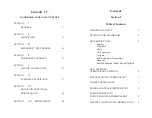
Page 22
Pilot’s Operating Manual
Revision A1: Nov, 2002
Hawker 800XP Pro Line 21
Section VII - SAFETY INFORMATION
This airplane has not been tested for spin recovery characteristics and intentional spins are prohibited.
The pilot of an airplane placarded against intentional spins should assume that the airplane may
become uncontrollable in a spin, since its performance characteristics beyond certain limits specified in
the FAA regulations may not have been tested and are unknown. This is why airplanes are placarded
against intentional spins and this is why stall avoidance is your protection against an inadvertent spin.
Pilots are taught that intentional spins are entered by deliberately inducing a yawing moment with the
controls as the airplane is stalled. Inadvertent spins result from the same combination - stall plus yaw.
That is why it is important to use coordinated controls and to recover at the first indication of a stall when
practicing stalls.
In any twin engine airplane, fundamental aerodynamics dictate that if the airplane is allowed to become
fully stalled while one engine is providing thrust, the yawing moment which can induce a spin will be
present.
Consequently, it is important to immediately reduce power on the operating engine, lower the nose to
reduce the angle of attack, and increase the airspeed to recover from the stall. In any twin engine
airplane, if application of stall recovery controls is delayed, a rapid rolling and yawing motion may
develop, even against full aileron and rudder, resulting in the airplane becoming inverted during the
onset of a spinning motion.
Once the airplane has been permitted to progress beyond the stall and is allowed to reach the rapid
rolling and yawing condition, the pilot must then immediately initiate the generally accepted spin
recovery procedure for multi-engine airplanes, which is as follows:
• Immediately move the control column full forward.
• Apply full rudder opposite to the direction of the spin.
• Reduce power on both engines to idle.
These three actions should be done as near simultaneously as possible, then continue to hold this
control position until rotation stops, then neutralize all controls and execute a smooth pullout.
THE LONGER THE PILOT DELAYS BEFORE TAKING CORRECTIVE ACTION, THE MORE
DIFFICULT RECOVERY WILL BECOME.
Always remember that extra alertness and pilot techniques are required for slow flight maneuvers,
including the practice or demonstration of stalls or V
MCA
. In addition to the foregoing mandatory
procedure, always:
• Be certain that the center of gravity of the airplane is as far forward as possible. Forward C.G. aids
stall recovery, spin avoidance and spin recovery. An aft C.G. can create a tendency for a spin to
flatten out, which delays recovery.
• Conduct any maneuvers which could possibly result in a spin at altitudes in excess of 5,000 feet
above ground level in clear air only.
• Remember that an airplane, at or near traffic pattern and approach altitudes, cannot recover from
a spin, or perhaps even a stall, before impact with the ground. When descending to traffic altitude
and during pattern entry and all other flight operations, maintain speed at a comfortable margin
above the V
REF
for the existing flap condition. On final approach maintain at least the V
REF
airspeed shown in the Airplane Flight Manual.
Содержание Hawker 800XP
Страница 18: ...Page 16 of 16 P N 140 590032 0007 Revision A5 Feb 2012 Pilot s Operating Manual Intentionally left blank...
Страница 20: ...Page 2 of 2 Pilot s Operating Manual P N 140 590032 0007LOTC September 22 2010 Intentionally left blank...
Страница 22: ...Page 2 of 2 P N 140 590032 0007A5 Log Of Revisions Intentionally left blank...

































